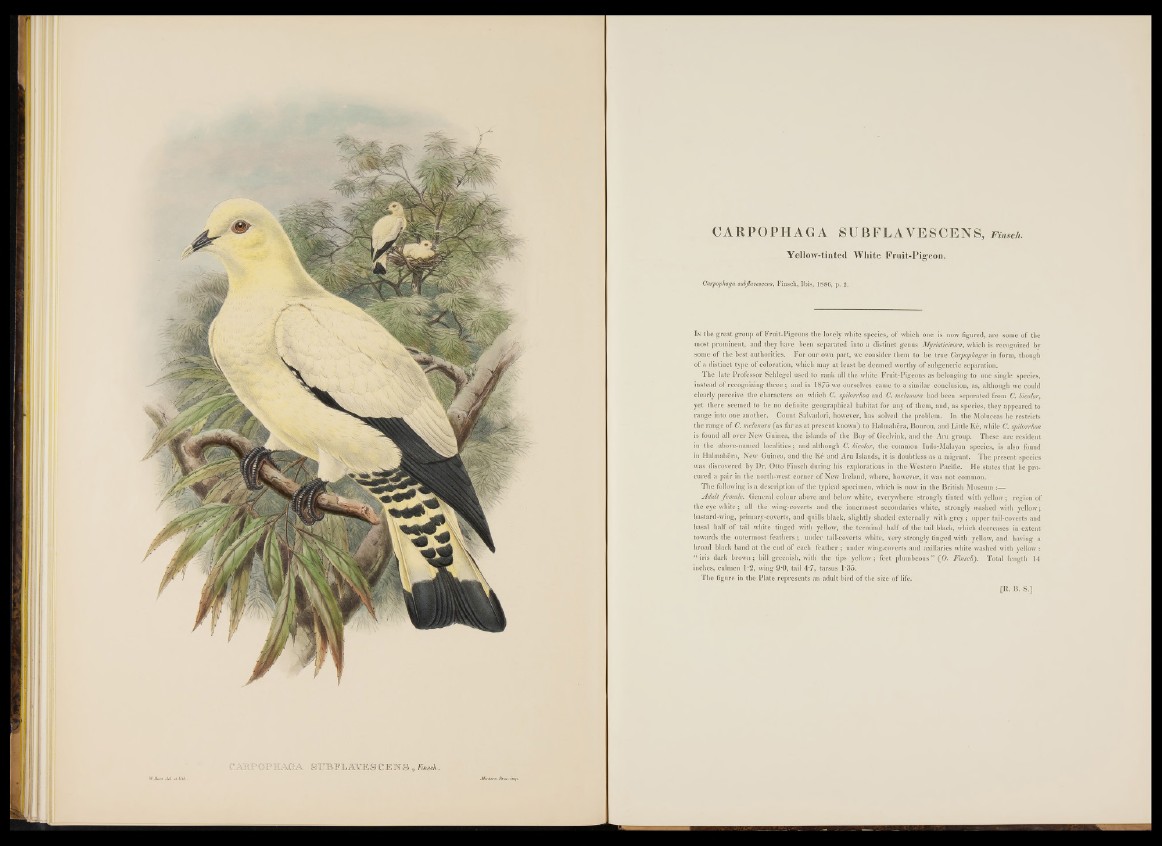
CARPOPHAGA SUBFLAYESCENS, Finsch.
Yellow-tinted White Fruit-Pig*eon.
Carpophaga stibjlavescens, Finsch, Ibis, 1886, p. 2.
In the great group of F ruit-Pigeons the lovely white species, of which one is now figured, are some of the
most prominent, and they have been separated into a distinct genus Myristicivora, which is recognized by
some o f the best authorities. F o r our own p art, we consider them to be true Carpophagce in form, though
o f a distinct type o f coloration, which may a t least be deemed worthy o f subgeneric separation.
The late Professor Schlegel used to rank all the white Fruit-Pigeons as belonging to one single species,
instead o f recognizing th ree ; and in 1875 we ourselves came to a similar conclusion, as, although we could
clearly perceive the characters on which C. spilorrhoa and C. melanura had been separated from C. bicolor,
yet there seemed to be no definite geographical habitat for any o f them, and, as species, they appeared to
range into one another. Count Salvadori, however, has solved the problem. In the Moluccas he restricts
the range of C. melanura (as far as a t p resent known) to Halmahera, Bourou, and Little K e, while C. spilorrhoa
is found all over New Guinea, the islands o f the Bay o f Geelvink, and the Aru group. These a re resident
in the above-named localities; and although C. bicolor, the common Indo-Malayan species, is also found
in Halmahera, New Guinea, and the Ke and Aru Islands, it is doubtless as a migrant. The present species
was discovered by Dr. Otto Finsch during his explorations in the Western Pacific. He states that he procured
a pair in the north-west corner o f New Ireland, where, however, it was not common.
T h e following is a description o f the typical specimen, which is now in the British Museum : -= 9 H
Adult female. General colour above and below white, everywhere strongly tinted with yellow; region of
the eye white; all the wing-coverts and the innermost secondaries white, strongly washed with yellow;
bastard-wing, primary-coverts, and quills black, slightly shaded externally with g r e y ; upper tail-coverts and
basal half o f tail white tinged with yellow, the terminal half o f the tail black, which decreases in extent
towards the outermost feathers ; under tail-coverts white, very strongly tinged with yellow, and having a
broad black band at the end o f each feather ; under wing-coverts and axillaries white washed with yellow :
“ iris dark brown ; bill greenish, with the tips yellow; feet plumbeous ” ( 0 . Finscli). Total length 14
inches, culmen 1*2, wing 9 ‘0, tail 4 -7, tarsus 1*35.
The figure in the Plate represents an adult bird o f the size o f life.
[It. B. S.]